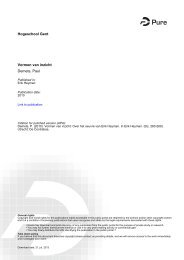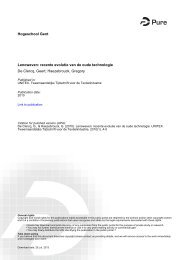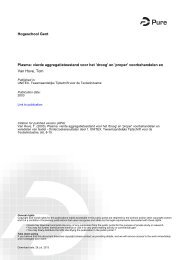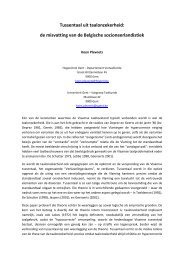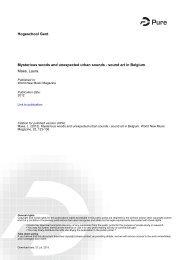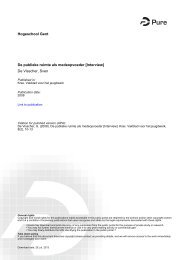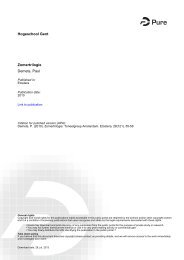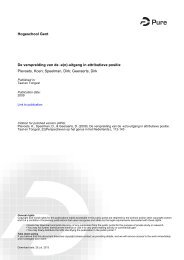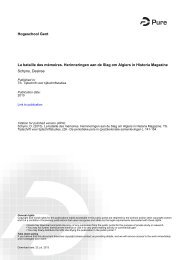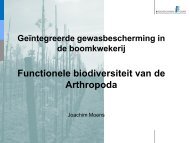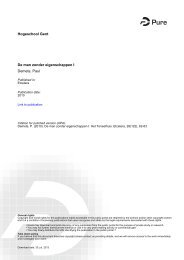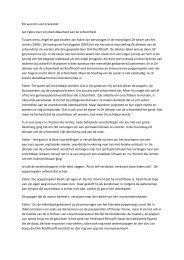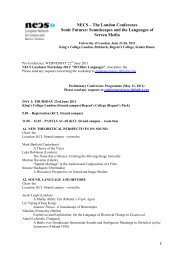- Page 1: Hogeschool Gent Biopreservation of
- Page 4 and 5: ir. Lieve Vermeiren Biopreservation
- Page 6 and 7: Woord vooraf Proefbuizen, labojasse
- Page 8: Table of contents
- Page 11 and 12: 3.4. EFFECT OF PROTECTIVE LAB ON TH
- Page 13 and 14: 1. INTRODUCTION....................
- Page 15 and 16: 2.8. STATISTICAL ANALYSES 189 3. RE
- Page 18 and 19: Introduction and objectives In rece
- Page 20 and 21: • Sub-objective 5 Chapter 5 aimed
- Page 22: Summary
- Page 25 and 26: Chapter 3 presented a systematic st
- Page 27: 10A and an atmosphere containing 50
- Page 32 and 33: Samenvatting Samenvatting De litera
- Page 34 and 35: In hoofdstuk 4 wordt onderzocht in
- Page 36 and 37: Hoofdstuk 7 beschrijft onderzoek na
- Page 38: Chapter 1 Antagonistic micro-organi
- Page 41 and 42: (Stiles & Holzapfel, 1997). Another
- Page 43 and 44: indole and alcohols, which play an
- Page 45 and 46: 1.4.4.3. Classification Although ea
- Page 47 and 48: temperature (4°C) and high salt (9
- Page 49 and 50: undissociated acid molecules enter
- Page 51 and 52: 1.5.1.3. Carbon dioxide Carbon diox
- Page 53 and 54: lanthionine and beta-methyllanthion
- Page 55 and 56: 1.5.2.3. Antimicrobial spectrum Kla
- Page 57 and 58: 2. The microbial ecology of anaerob
- Page 59 and 60: Björkroth, 1997; Holzapfel, 1998;
- Page 61 and 62: 2001). The predominant spoilage cha
- Page 63 and 64: 2.4. Safety 2.4.1. Pathogens associ
- Page 65 and 66: 3. Biopreservation Since the role o
- Page 67 and 68: 1991; Motlagh et al., 1992), cooked
- Page 69 and 70: Combinations of lactate and acetate
- Page 71 and 72: products late blowing and/or growth
- Page 73 and 74: protect against L. monocytogenes (L
- Page 75 and 76: Table 1.4. Effect of various bacter
- Page 77 and 78: Table 1.5. Studies on the effect of
- Page 79 and 80:
L. monocytogenes in frankfurters (A
- Page 81 and 82:
genome is injected into the cell, (
- Page 83 and 84:
3.3.2.3. Issues to consider in biop
- Page 85 and 86:
while others did notice the emergen
- Page 87 and 88:
acidic than the controls. Indeed, t
- Page 89 and 90:
3.5.1.3. Bacteriocin production Whe
- Page 91 and 92:
3.5.2.2. Competition for amino acid
- Page 93 and 94:
of the non-Saccharomyces yeasts to
- Page 95 and 96:
mammalian cells. When exposed to ba
- Page 97 and 98:
2005, the scientific committee of E
- Page 100:
Chapter 2 Evaluation of meat born l
- Page 103 and 104:
1. Introduction Cured cooked meat p
- Page 105 and 106:
sulphate of 100 IU/ml of medium. Af
- Page 107 and 108:
storage under an atmosphere of 100%
- Page 109 and 110:
The MCH was inoculated with the 12
- Page 111 and 112:
Table 2.1. Overview of ‘collected
- Page 113 and 114:
Earlier results (not shown) indicat
- Page 115 and 116:
Zone (mm) Zone (mm) 20 18 16 14 12
- Page 117 and 118:
way, the time to acidification star
- Page 119 and 120:
Log10(cfu/g) 8.5 8.0 7.5 7.0 6.5 6.
- Page 121 and 122:
decreased to a value of about 5.80-
- Page 123 and 124:
Scores for general appearance, colo
- Page 125 and 126:
of the storage experiment, on some
- Page 128 and 129:
Chapter 3 In-vitro and in-situ grow
- Page 130 and 131:
ate, acidifying character and metab
- Page 132 and 133:
formation of large ice crystals and
- Page 134 and 135:
Figure 3.1 shows the levels of lact
- Page 136 and 137:
dominance of the inoculated strains
- Page 138 and 139:
For none of the strains, a signific
- Page 140 and 141:
acid, depending on the heterofermen
- Page 142:
cooked ham samples inoculated with
- Page 146 and 147:
Chapter 4 Co-culture experiments de
- Page 148 and 149:
Protective cultures can be divided
- Page 150 and 151:
slices) of cooked ham. After inocul
- Page 152 and 153:
disc diffusion method (Gevers et al
- Page 154 and 155:
Both potential PC grew well on the
- Page 156 and 157:
Log10(cfu/g) Log10(cfu/g) 9 8 7 6 5
- Page 158 and 159:
Table 4.2. Evolution of the pH in t
- Page 160 and 161:
In the interaction studies between
- Page 162 and 163:
Log10(cfu/g) Log10 (cfu/g) 9 8 7 6
- Page 164 and 165:
B. thermosphacta BT1. When artifici
- Page 166:
shelf-life prolongation of cooked m
- Page 170 and 171:
Chapter 5 The interaction of the no
- Page 172 and 173:
on the same model cooked ham (MCH)
- Page 174 and 175:
inoculation, slices were vacuum pac
- Page 176 and 177:
Log10(cfu/g) 9 8 7 6 5 4 3 2 1 0 0
- Page 178 and 179:
7 days and remained at that cell nu
- Page 180 and 181:
an increase in cell number of 2 log
- Page 182:
inhibitory effect of glucose was ab
- Page 186 and 187:
Chapter 6 The sensory acceptability
- Page 188 and 189:
This hypothesis still does not agre
- Page 190 and 191:
in a water bath, centrifuged at 800
- Page 192 and 193:
Immediately after production, produ
- Page 194 and 195:
iopreserved samples and control sam
- Page 196 and 197:
present in CMP can originate from e
- Page 198 and 199:
0.82 and 0.84 pH-units respectively
- Page 200 and 201:
Log10(cfu/g) Log10(cfu/g) 9 8 7 6 5
- Page 202 and 203:
3.2.2. Glucose consumption and lact
- Page 204 and 205:
Table 6.4. Evolution of the pH ± S
- Page 206 and 207:
the time at which the products were
- Page 208 and 209:
3.3.2. Role of glucose and bufferin
- Page 210:
However, from a technological point
- Page 214 and 215:
Chapter 7 The contribution of lacti
- Page 216 and 217:
food products (Nilsson et al., 1999
- Page 218 and 219:
2.3. Experimental set-up The outlin
- Page 220 and 221:
three jars were opened to prepare f
- Page 222 and 223:
BHI-P differed from CFS-P and CFS i
- Page 224 and 225:
oth than on CMP. Furthermore, the g
- Page 226 and 227:
3.2. Role of lactic acid production
- Page 228 and 229:
acid production amounted to 1.62 ±
- Page 230 and 231:
This time, growth inhibition was no
- Page 232 and 233:
By comparing the growth of Listeria
- Page 234 and 235:
3.3. Co-culture experiments - suppl
- Page 236 and 237:
This result might indicate that the
- Page 238:
acid production/pH-reduction was in
- Page 242 and 243:
Chapter 8 Treatment with bacterioph
- Page 244 and 245:
for its work the strictly lytic pha
- Page 246 and 247:
the inoculum of the three-strain L.
- Page 248 and 249:
oth was transferred to 10 ml Fraser
- Page 250 and 251:
grown due to the action of P100 or
- Page 252 and 253:
Table 8.1 shows the effect of phage
- Page 254 and 255:
treatment of cooked ham with P100 s
- Page 256 and 257:
shelf-life of cooked meat products
- Page 258:
General discussion, conclusions and
- Page 261 and 262:
associated with anaerobically packa
- Page 263 and 264:
acteriocinogenic L. sakei 10A and n
- Page 265 and 266:
indicate that glucose is the main c
- Page 267 and 268:
From a scientific point of view, la
- Page 270 and 271:
List of abbreviations AR Acidificat
- Page 272:
References
- Page 275 and 276:
14. Atterbury, R.J., Connerton, P.L
- Page 277 and 278:
38. Borch, E. & Agerhem, H. (1992).
- Page 279 and 280:
62. Champomier-Vergès, M.-C., Chai
- Page 281 and 282:
87. Einarsson, H. & Lauzon, H.L. (1
- Page 283 and 284:
112. Greer, G.G. (1983). Psychrotro
- Page 285 and 286:
138. Juven, B.J., Barefoot, S.F., P
- Page 287 and 288:
162. Leroy, F. & Devuyst, L. (1999b
- Page 289 and 290:
187. Montville, T.J. & Bruno, M.E.C
- Page 291 and 292:
213. Pucci, M.J., Vedamuthu, E.R.,
- Page 293 and 294:
240. Schnürer, J. & Magnusson, J.
- Page 295 and 296:
265. Valerio, F., Lavermicocca, P.,
- Page 298:
Curriculum vitae
- Page 301 and 302:
List of publications Papers in inte
- Page 303 and 304:
International Symposium on food pac
- Page 305 and 306:
‘Inhibitory spectrum of bacterioc



